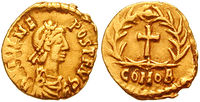Julius Nepos
| Flavius Julius Nepos | |
|---|---|
| Emperor of the Western Roman Empire |
|
 |
|
| Tremissis of Julius Nepos | |
| Reign | June 474 – August 28, 475 (ruling from Italy) 475 – 480 (ruling from Dalmatia) |
| Born | c. 430 |
| Died | April 25, May 9 or June 22, 480 (aged 50) |
| Place of death | Spalatum, Dalmatia |
| Predecessor | Glycerius |
| Successor | Romulus Augustus |
| Wife | Niece of Leo I |
| Father | Nepotianus |
| Mother | A sister of Marcellinus |
Julius Nepos[1] (c. 430 – 480) was Western Roman Emperor de facto from 474 to 475 and de jure until 480. Some historians consider him to be the last western Roman Emperor, while others consider the western line to have ended with Romulus Augustus in 476. In contrast, the Eastern Roman Empire, and its line of Emperors, survived this historical period relatively intact.
Contents |
Overview
Julius Nepos was nominated Emperor of the West in 474 by the Eastern Roman Emperor, Leo I. He was married to Leo's wife's niece, earning him the agnomen "Nepos" (nephew). Nepos was appointed to replace the Western Emperor Glycerius, who was regarded as a usurper. After Glycerius' surrender, in June 474, Nepos briefly ruled over the whole of the remaining Western Empire, including Italy; still the empire's heartland, although its administrative capital had been moved in and out of Rome repeatedly, and was at that time located in Ravenna. Nepos' rule in Italy ended when he was deposed by one of his military commanders, Flavius Orestes, in 475. After Nepos fled from Italy and Orestes, without opposition, he resumed his rule only over Dalmatia, where he took up residence, and the remainder of Roman Gaul.
Following Nepos' departure, Orestes enthroned his own teenage son as the new Western Emperor in the same year, with the regnal name Romulus Augustus; the second element often being used as a nickname, in the diminutive "Augustulus" (little Augustus).
In eyes of the Roman constitution, Romulus Augustus was yet another usurper;[2] his short reign ended in 476, with the execution of his father, and his own subsequent deposition, both by Odoacer, the leader of the Foederati. Odoacer, the new ruler of Italy, sent the boy ex-emperor to Campania, in exile or retirement, after which Romulus Augustus disappears from the historical record.
Although his successor had been deposed, Nepos never returned from Dalmatia. However, he continued to be recognized as Western Emperor by the Eastern Roman Empire, Roman Gaul, and Dalmatia itself. Odoacer also acknowledged Nepos' Imperial status, and even issued coinage in his name.
Through the Roman Senate, Odoacer requested that he be named a Patrician by Emperor Zeno, ruler of the eastern half of the Roman Empire. This request was granted and technically Odoacer, as Patrician, ruled Italy and an expanding sphere of related territories under Zeno's authority as the head of a "re-united" Imperium Romanum. In practical terms, Odoacer was an increasingly independent king, nominally recognizing the Eastern Emperor's suzerainty, with Nepos retaining a tenuous claim on the Imperial rank.
Julius Nepos, still residing in Dalmatia, was murdered in 480. His death ended the last serious legal claims of a Western Empire, independent of the Roman East, until the rise of the Carolingian "Holy" Roman Empire at the beginning of the 800s.
Family
Julius Nepos was a son of Nepotianus, who served as magister militum of the Western Roman Empire between 458 and 461. His unnamed mother was a sister of Marcellinus, magister militum of Dalmatia.[3] Marcellinus Comes, a historian not related to either man, mentions Nepos as "son of the sister of Marcellinus, once patrician".[4] A passage of Jordanes' Getica gives the same identification of Nepos.[5] Since Jordanes often uses Marcellinus Comes as a source, the passage might have been copied verbatim.[4]
Nepos might have belonged to a prominent family of Dalmatia. There are four memorial inscriptions from the area commemorating similarly-named individuals: Aelia Nepotes, Aelia Nepos, Julius Nepos and Nepotes. The name seems to also be preserved in an church inscription of Salona, dating to the early 5th century.[6]
Rise to power
Nepos was married to the niece of Eastern Roman Emperor Leo I, hence his nepos — "nephew" — agnomen, and was named as Emperor in the West by Leo in 474, in order to end the reign of the usurper Glycerius, who had been raised to the throne by the Burgundian magister militum Gundobad in the western capital of Ravenna. Officially, however, Leo was the sole Emperor and had the right to select a new Western Emperor. He chose Nepos, the governor of the province of Dalmatia, and in June 474 Nepos entered Ravenna, forced Glycerius to abdicate and was himself raised to the Purple. Glycerius was essentially exiled to Dalmatia as bishop of the city of Salona, where he and Nepos would later to cross paths again.
Rule
As emperor, Nepos tried to consolidate the empire's remaining Western holdings, which consisted of Italy, part of the Balkans and footholds in northern and southern Gaul. He was able to renegotiate a recently concluded peace settlement with the Visigoths and their king Euric, which restored the Provence region of Gaul to imperial control in exchange for some other, minor territories where Nepos was unable to maintain firm control. But he was less successful in negotiating with Geiseric, the king of the Vandals, who was once again launching pirate attacks on the Italian coast. Having recently made peace with the eastern Empire, Geiseric saw no need to make new concessions to Nepos.
Nepos was, by all accounts, one of the more capable of the late Western Emperors, but he was unpopular with the Roman Senate, the members of which disliked him for his close ties to the east. When Nepos made the mistake of appointing the untrustworthy Orestes as his magister militum, his lack of a western core of support came back to haunt him.
Fall and rule from Dalmatia
On August 28, 475, Orestes took control of the government at Ravenna and forced Nepos to flee by ship to Dalmatia. Unable to appoint himself as the Western Roman Emperor, Orestes instead appointed his son Romulus Augustus. Romulus was a citizen of Rome. The boy was probably around 12 years old when he became Emperor and is ironically known to history as Romulus Augustulus, meaning Romulus the Little Augustus.
However, Nepos continued to rule in Dalmatia as the rightful Western Roman Emperor. He continued to be recognized as such in Gaul and in the eastern court. When Odoacer captured Ravenna, killed Orestes, and deposed Romulus on September 4, 476, he proclaimed himself ruler of Italy and asked the Eastern Roman Emperor Zeno to legalize his position as Patricius of the Roman Empire and Zeno's viceroy in Italy. Zeno did so, but insisted that he recognize Nepos as Western Roman Emperor. Odoacer did this, and even issued coins in Nepos' name throughout Italy. A similar situation persisted in north Gaul where the Roman general Syagrius minted coins in Nepos' name until his defeat in 486. In name at least, the Western Roman Empire continued to exist after 476, but only as a legal formality and as a sop to imperial tradition.
Similar arrangements might have continued for many years had events not taken another course. First, in about 479, Nepos began to plot against Odoacer, hoping to regain control of Italy for himself. Another possibility, (according to some sources) is that Glycerius, who continued as bishop of Salona, was plotting his revenge. What is certain is that Odoacer perceived Nepos as a threat, and was determined to get rid of him.
Murder
Nepos was murdered by his own soldiers on one of three possible dates — April 25, May 9 or June 22 — of 480. The April 25 date is probably the correct one [7]. He was reportedly stabbed to death in his villa, near Salona. Since Diocletian also had a residence in the area, it might have been the same building. Marcellinus Comes blames "the treachery of his comes Viator and Ovida" for the murder. Malchus also implicates the former Emperor Glycerius in the conspiracy. Glycerius was after all Bishop of Salona at the time, placing him in the vicinity of the murder. [8]
Ovida served as the next ruler of Dalmatia for a few months, but Odoacer used Nepos' murder as a pretext to invade Dalmatia.[8] Odoacer defeated Ovida's forces on December 9, and added the province to his own kingdom. Adding to the suspicions about Glycerius is a report that Odoacer then made him bishop of Milan.
Sources
- MacGeorge, Penny (2002). Late Roman warlords. Oxford University Press. ISBN 0199252440.
References
- ↑ Prosopography of the Later Roman Empire II.777
- ↑ J. B. Bury, History of the Later Roman Empire, §4, p. 408.
- ↑ Ralph W. Mathisen, "Julius Nepos (19/24 June 474 – [28 August 475 – 25 April/9 May/22 June 480)"
- ↑ 4.0 4.1 MacGeorge (2002), p. 29
- ↑ Jordanes, "The Origins and Deeds of the Goths". Chapter XLV (45). 1915 translation by Charles C. Mierow
- ↑ MacGeorge (2002), p. 42
- ↑ Ensslin, Wilhelm, “Julius Nepos”, in Paulys Realencyclopädie der classischen Altertumswissenschaft, Band XVI,2 (1935), S. 1505–1510.
- ↑ 8.0 8.1 MacGeorge (2002), p. 62
External links
 Media related to Julius Nepos at Wikimedia Commons
Media related to Julius Nepos at Wikimedia Commons Chisholm, Hugh, ed (1911). "Nepos, Julius". Encyclopædia Britannica (Eleventh ed.). Cambridge University Press.
Chisholm, Hugh, ed (1911). "Nepos, Julius". Encyclopædia Britannica (Eleventh ed.). Cambridge University Press.
|
Julius Nepos
House of Leo
Born: 430 Died: 480 |
||
| Regnal titles | ||
|---|---|---|
| Preceded by Glycerius |
Western Roman Emperor 474–475 |
Succeeded by Romulus Augustulus |
| Preceded by Glycerius |
Roman Emperor 474–480 |
Succeeded by Zeno as Emperor of the whole empire |
| Preceded by Marcellinus |
Military governor or ruler of Dalmatia 468–480 |
Succeeded by Ovida |
|
|||||||||||||||||||||||